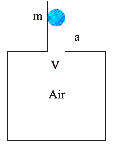Which of the following functions of time represent (a) simple harmonic, (b) periodic but not simple harmonic, and (c) non-periodic motion? Give period for each case of periodic motion (ω is any positive constant):
(a) sinωt−cosωt
(b) sin3ωt
(c) 3cos(π/4−2ωt)
(d) cosωt+cos3ωt+cos5ωt
(e) exp(−ω2t2)
(f) 1+ωt+ω2t2Solution in Gujrati
The function will represent a periodic motion, if it is identically repeated after a fixed interval of time and will represent SHM if it can be written uniquely in the form of cos(2πT+ϕ) or a sin(2πT+ϕ), where T is the time period.
cosωt+cos3ωt+cos5ωt
It represents the periodic but not SHM.
The time period for cosωtT=2πω
The time period for cos3ωt is 2π5ω=T3 and the time period for cos5ωt is 2π5ω=T5.
Since every function indicates periodic motion but their time period are different but in the combination of these functions, periodic time taken as minimum. Hence for a given function, the periodic time is 2πω.
Topper's Solved these Questions
- OSCILLATIONSBOOK - KUMAR PRAKASHANCHAPTER - OSCILLATIONSEXERCISE - SECTION-B (ADDITIONAL EXERCISE)
9 Videos
- OSCILLATIONSBOOK - KUMAR PRAKASHANCHAPTER - OSCILLATIONSEXERCISE - SECTION-B (NUMERICAL FROM DARPAN BASED ON TEXTBOOK)
15 Videos
- OSCILLATIONSBOOK - KUMAR PRAKASHANCHAPTER - OSCILLATIONSEXERCISE - SECTION-B (NUMERICAL FROM TEXTUAL ILLUSTRATIONS)
40 Videos
- OBJECTIVE QUESTIONS AS PER NEW PAPER STYLE BOOK - KUMAR PRAKASHANCHAPTER - OBJECTIVE QUESTIONS AS PER NEW PAPER STYLE EXERCISE - CHAPTER - 8 (Match Type questions)
5 Videos
- PHYSICAL WORLDBOOK - KUMAR PRAKASHANCHAPTER - PHYSICAL WORLDEXERCISE - SECTION-E (QUESTIONS FROM MODULE)
9 Videos
Similar Questions
An air chamber of volume V has a neck area of cross section a into which a ball of mass m just fits and can move up and down without any friction (Fig.14.27). Show that when the ball is pressed down a little and released , it executes SHM. Obtain an expression for the time period of oscillations assuming pressure-volume variations of air to be isothermal [see Fig. 14.27].

View SolutionThe displacement of a simple harmonic oscillator is given by y=0.40sin(440t+0.61). For this, what are the value of amplitude.
View SolutionOn an average, a human heart is found to beat 75 times in a minute. Calculate its frequency and period.
View SolutionType of satellites are given in Column-I and their uses are given in Column-II. Match them properly :
Column-IColumn-II(1) Polar satellite(a) Tele communication(2) Geo-stationary satellite(b) Investigation(c) For information about atmosphere
View Solution.…. state of substance at very high temperature has generated hope of energy source for mankind.
View SolutionWhich of the following functions of time represent (a) simple harmonic, (b) periodic but not simple harmonic , and (c) non-periodic motion ? Give period for each case of periodic motion , omega is any positive constant). ltbr> (a) sinomegat-cosomegat) (b) sin^(3)omegat (c) 3cos((pi)/(4)-2omegat) (d) cosomegat+cos3omegat+cos5omegat) (e) exp(-omega^(2)t^(2)) (f) 1+omegat+omega^(2)t^(2)
View SolutionWhich of the following functions of time represent (a) simple harmonic (b) periodic but not simple harmonic and (c ) non periodic motion? Give period for each case of periodic motion (omega is nay positive constant) (1) Sin^(3) omegat (2) 3cos (pi//4 -2 omegat) (3) cos omegat +cos 3 omegat + cos 5 omegat (4) e^(-omega^(2)t^(2)) (5) 1 + omegat +omega^(2) t^(2)
View Solutionनिचे दिए गये समय के फलनों में कौन (a) सरल आवर्त गति (b) आवर्ती परन्तु सरल गति नहीं, तथा (c) अनावर्ती गति को निरूपण करते है। प्रत्येक आवर्ती गति का आवर्तकाल ज्ञात कीजिए : (ω कोई धनात्मक अचर है।)
(a) sinωt−cosωt
(b) sin3ωt
(c) 3cos(π4−2ωt)
(d) cosω+cos3ωt+cos5ωt
(e) exp (−ω2t2)
(f) 1+ωt+ω2t2
View Solutionनीचे दिये गये समय के फलनों में कौनसा
(a) सरल आवर्त गति
(b) आवर्ती परन्तु सरल आवर्त गति नहीं, तथा
(c) अनावर्ती गति का निरूपण करते हैं। प्रत्येक आवर्ती गति का आवर्तकाल ज्ञात कीजिये:(ω कोई धनात्मक अचर है।)
(a) sinωt−cosωt
(b) sin3ωt
(c) 3cos(π4−2ωt
(d) cosωt+cos3ωt+cos5ωt
(e) exp(−ω2t2)<br>(f)1 + omegat + omega^(2)t^(2)
View SolutionWhich of the following functions of time represent (i) simple harmonic, (ii) periodic but not simple harmonic, and (iii) non-periodic motion? Give period for each case of periodic motion (ω is any positive constant):
(a) sinωt−cosωt
(b) sin3ωt
(c) 3cos(π/4−2ωt)
(d) cosωt+cos3ωt+cos5ωt
(e) exp (−ω2t2)
(f) 1+ωt+ω2t2
View SolutionWhich of the following functions of time represent (a) simple harmonic, (b) periodic but not simple harmonic, and (c) non-periodic motion? Give period for each case of periodic motion (ω is any positive constant):
(a) sinωt−cosωt
(b) sin3ωt
(c) 3cos(π/4−2ωt)
(d) cosωt+cos3ωt+cos5ωt
(e) exp(−ω2t2)
(f) 1+ωt+ω2t2
View SolutionWhich of the following functions of time represent (a) simple harmonic, (b) periodic but not simple harmonic, and (c) non-periodic motion? Give period for each case of periodic motion (ω is any positive constant):
(a) sinωt−cosωt
(b) sin3ωt
(c) 3cos(π/4−2ωt)
(d) cosωt+cos3ωt+cos5ωt
(e) exp(−ω2t2)
(f) 1+ωt+ω2t2
View SolutionWhich of the following functions of time represent (a) simple harmonic, (b) periodic but not simple harmonic, and (c) non-periodic motion? Give period for each case of periodic motion (ω is any positive constant):
(a) sinωt−cosωt
(b) sin3ωt
(c) 3cos(π/4−2ωt)
(d) cosωt+cos3ωt+cos5ωt
(e) exp(−ω2t2)
(f) 1+ωt+ω2t2
View SolutionWhich of the following functions of time represent (a) simple harmonic, (b) periodic but not simple harmonic, and (c) non-periodic motion? Give period for each case of periodic motion (ω is any positive constant):
(a) sinωt−cosωt
(b) sin3ωt
(c) 3cos(π/4−2ωt)
(d) cosωt+cos3ωt+cos5ωt
(e) exp(−ω2t2)
(f) 1+ωt+ω2t2
View SolutionWhich of the following functions of time represent (a) simple harmonic, (b) periodic but not simple harmonic, and (c) non-periodic motion? Give period for each case of periodic motion (ω is any positive constant):
(a) sinωt−cosωt
(b) sin3ωt
(c) 3cos(π/4−2ωt)
(d) cosωt+cos3ωt+cos5ωt
(e) exp(−ω2t2)
(f) 1+ωt+ω2t2
View SolutionWhich of the following functions of time represent (a) simple harmonic motion and b. periodic but not simple harmonic? Give the period for each case. (1) sin omega t -cos omega t 2. sin^(2)omega t
View Solution
